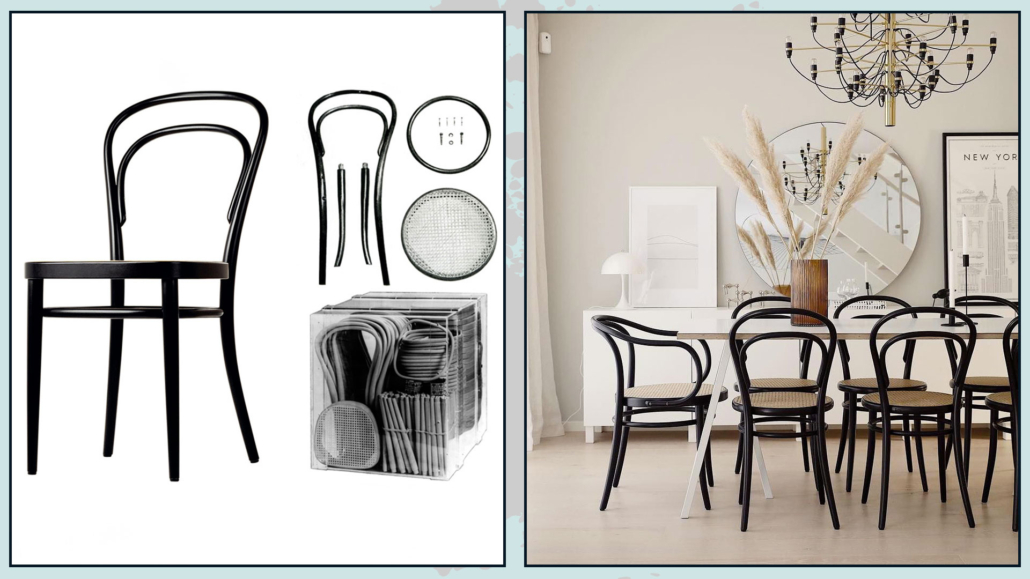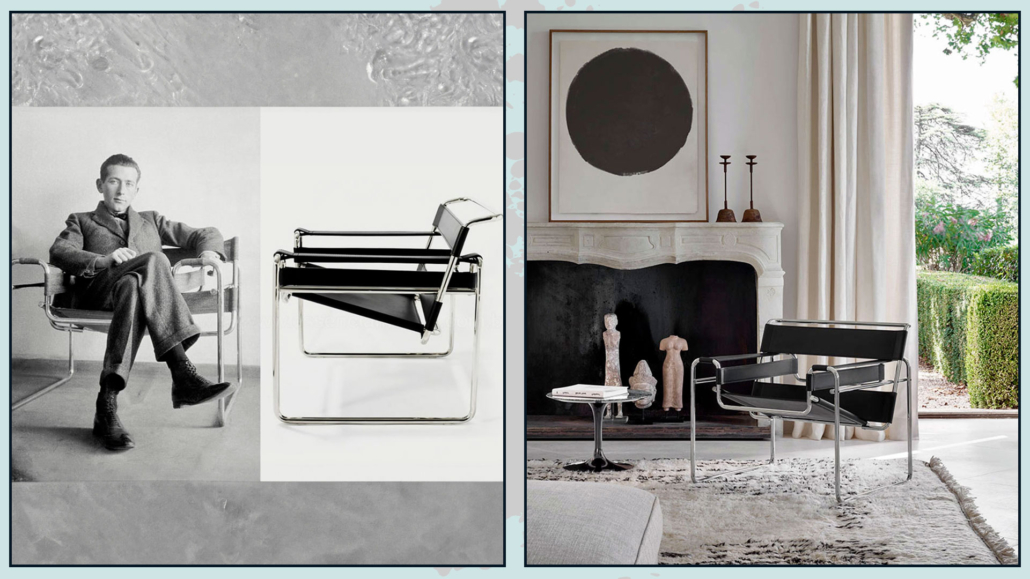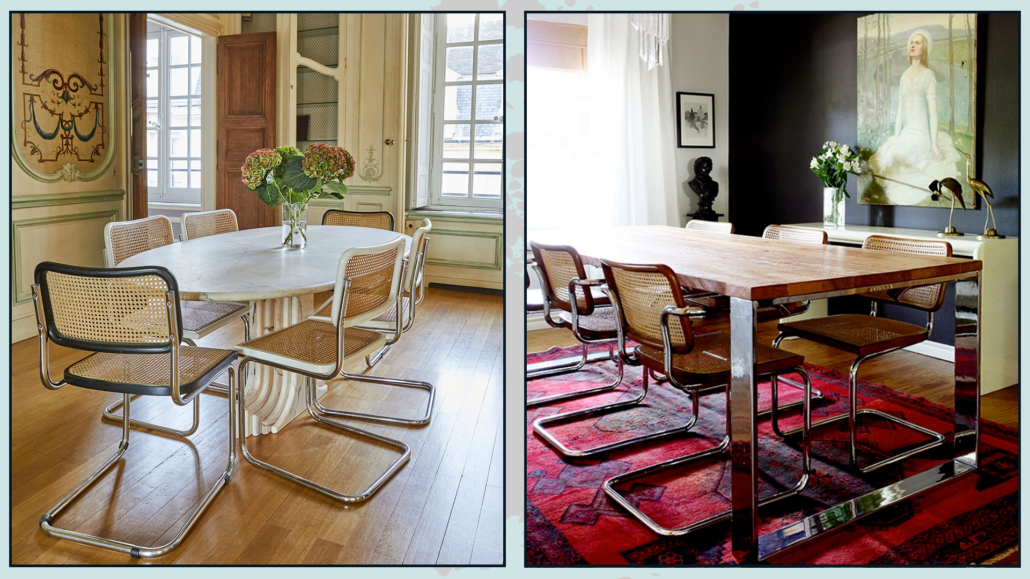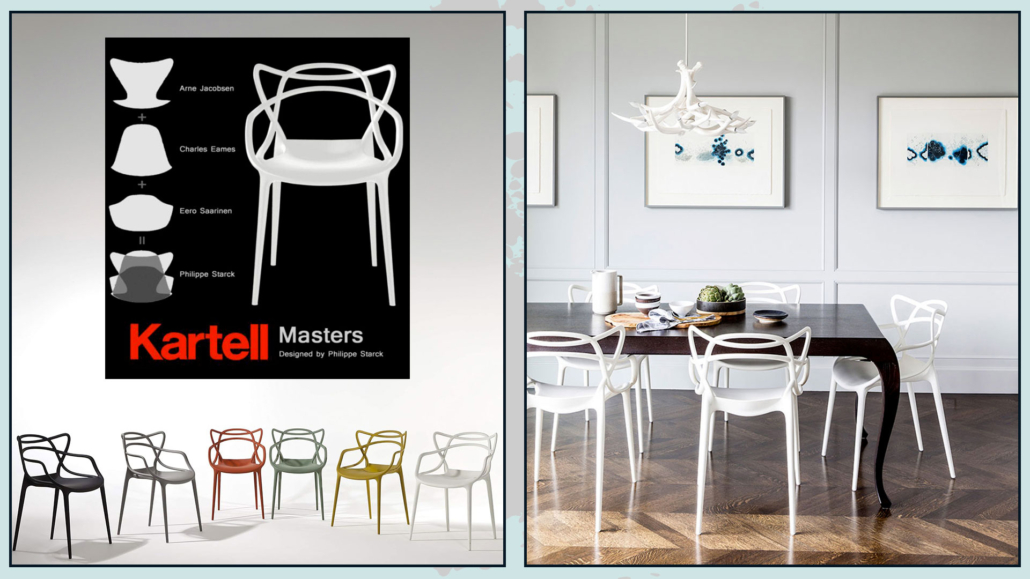Today, we return to the Design Elements column, discussing 5 historic and famous design chairs (you can find 10 more here!).
1 – THONET 214 CHAIR
Designed by Michael Thonet (an Austro-Hungarian cabinetmaker) for the eponymous company in 1859, it is an undisputed icon in furniture history.
Since its inception, this chair has remained the most successful and widely produced globally.
It is the first seat made from steam-bent wood, with a seat woven in straw.
It is known as the Bistro chair because it appeared in bars and restaurants in Vienna.
Due to being one of the first industrial products, the chair was sold at significantly lower prices than handmade chairs.
Comprising only six pieces of wood assembled with ten screws and two nuts, it has an essential and light appearance, featuring a classic design that also complements modern styles.
The renowned architect Le Corbusier described the chair as “the best design product in history for its ability to integrate technique and style.”
This chair is displayed as a work of art in many museums, such as the MoMA in New York and the Vitra Design Museum in Germany.

(credit: Thonet; @emmamelins)
2 – WASSILY CHAIR (formerly B3)
Designed by Marcel Breuer (Hungarian architect and designer, a prominent figure at Bauhaus) in 1925 and produced by his own company, Standard-Mobel Lengyel, in Berlin; then, the company was later absorbed by Thonet in 1929.
The chair gained recognition and mass production in the 1960s when Dino Gavina met Breuer and suggested reimagining the chair for his eponymous company (which was later bought by Knoll in 1968).
The name of the chair was also Gavina’s idea: Wassily, in honor of Wassily Kandinsky, a friend of Breuer and a great enthusiast of the chair.
It appears that Breuer drew inspiration from his Adler bicycle in using steel tubing to design and construct this chair.
That turned out to be a brilliant idea because steel tubing was readily available in large quantities, effectively initiating the production of steel tubular furniture.
Breuer employed the techniques of local plumbers to bring the chair to life.
The seat, backrest, and armrest are bands of eidengarn fabric: cotton treated with wax and paraffin, calendered by passing it between two rollers!
That is an innovation, a new material created in the furniture workshops of the Bauhaus, where Breuer served as the director.
Initially, the chair featured steel and black textiles, and later, to “soften” it, a version with cream-colored ones was introduced.
It is also available in red and other softer colors.
In 2019, for the centenary of the Bauhaus’s founding, a limited edition was crafted with black tubing: 500 units were produced, each bearing the Knoll seal, Breuer’s signature, and a unique serial number on the base.

(credits: Bauhaus; Knoll)
3 – CESCA CHAIR (Formerly B32)
Designed, like the previous one, by Marcel Lajos Breuer in 1928 and currently produced by Knoll, the Cesca chair draws inspiration from two historical seats: the MR10 by Van der Rohe and the Thonet 214.
It features a steel structure (similar to the Wassily) quite akin to Van der Rohe’s design, though more angular, while its seat and backrest are made of wood and Vienna straw, reminiscent of the Thonet 214.
Being a cantilever chair, it deviates from the traditional four-legged design, relying on a single tubular structure for support.
The combination of structural innovation and classic seat and backrest materials gives the chair a contemporary and versatile appeal, making it suitable for integration into various styles.
The carefully composed structure makes the frame visually lightweight yet remarkably durable and flexible.
It’s a very comfortable chair, available with or without armrests and with upholstered seats (and optionally backrests) for added comfort.
Interesting fact: given the resemblance to Mies Van Der Rohe’s chair, Breuer faced quite a few legal issues, to the extent that he couldn’t claim ownership of this chair and had to stop designing with tubular steel.
Despite everything, his name remained associated with the chair in various industry magazines.
In the 1960s, when the Gavina company acquired the design rights, Breuer was once again credited as the designer, and the chair’s name changed from B32 to Cesca after Breuer’s daughter, Francesca.
The Cesca chair remains one of the most imitated and best-selling chairs in the world.

(credits: tamsinjohnson.com)
4 – LOUIS GHOST CHAIR
Designed by Philippe Starck (French architect and designer) in 2002 for Kartell, the Louis Ghost Chair playfully nods to Louis XV-style armchairs and is crafted from polycarbonate.
Classic-baroque in style but modern in materials and production techniques, it took two years to perfect the injection molding process, ensuring the chair could be produced in a single mold without any joints or attachments.
This process, today, has been further refined, with a significant portion of the polycarbonate sourced from industrial waste from cellulose and paper production.
That reduces carbon dioxide emissions, resulting in a 60% reduction in environmental impact.
Due to its transparency, the chair is suitable for any setting and looks perfect even around an antique wooden table.
Undoubtedly one of Kartell’s best sellers, it holds the title of the world’s best-selling chair, despite not being the first transparent chair by the brand, which is the Marie.
In addition to the pure transparent version (crystal), you can also find the Louis Ghost Chair in other delicate colors, always maintaining its transparency, as well as in white or black.
You can also find original transformations, such as Teddie bear, Barbie-themed, with wings, illuminated, and more.
You can find it virtually everywhere, from restaurants to theaters, in numerous homes, and even on television.
Surprisingly, it has made appearances in religious ceremonies as well. In 2007, during an outdoor celebration with Pope Benedict XVI, we saw religious figures seated beside him on Louis Ghost chairs.
Even Queen Elizabeth II sat on a Louis Ghost Chair in 2018, sitting next to Anna Wintour while attending Richard Queen’s fashion show.

(credits: H2 Design and Build; Teresa Sapey)
5 – MASTERS CHAIR
Designed by Philippe Starck in 2010 and Eugeni Quitllet (Spanish designer) again for Kartell.
The Masters’ Chair features a distinctive backrest that, at first glance, appears to be an aesthetically pleasing weave.
However, it is, in fact, a tribute to three iconic chairs: the Series 7 by Arne Jacobsen, the Tulip Armchair by Eero Saarinen, and the Eiffel Chair by Charles Eames.
The profiles of the backrests of these chairs are overlaid and intertwined, creating a chair that, in itself, becomes an icon.
The chair is made from polypropylene, a material similar to expanded polystyrene, known for its high mechanical elasticity and durability.
It is lightweight, comfortable, stackable, and available in many colors, including metallic finishes.
These features make it highly versatile, and it earned the Good Design Award in 2010 from the Chicago Athenaeum Museum of Architecture and Design.
The Masters’ Chair also exists in a tall stool version suitable for kitchen islands, peninsulas, and bar counters.

(credits: Kartell; Lauren Nelson Design)
I hope this article has been helpful and enjoyable for you. If so, let me know in the comments!
Feel free to share it with anyone you think might be interested, I would be honored, and it will help me gain more exposure.
If you feel that your home, or any specific area of it, doesn’t reflect your personality enough, don’t wait any longer and book your consultancy!
This post is also available in: Italian









Leave a Reply
Want to join the discussion?Feel free to contribute!